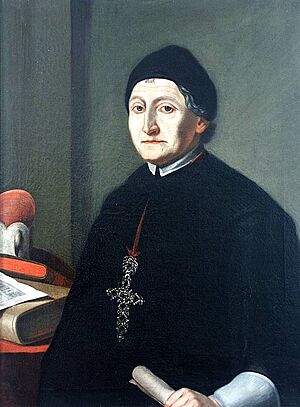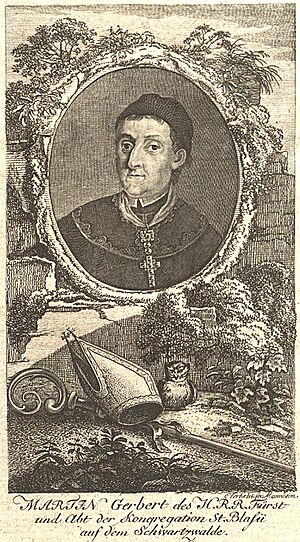Martin Gerbert facts for kids
Martin Gerbert (born August 11, 1720 – died May 3, 1793) was a very important German scholar. He was a theologian (someone who studies religion), a historian (someone who studies the past), and a writer about music. He came from a noble family and was born in Horb am Neckar, a town in Germany.
Contents
A Life of Learning and Leadership
Martin Gerbert studied in different places, including Freiburg im Breisgau and Klingnau in Switzerland. In 1737, he joined the Benedictine monastery of St. Blaise's Abbey in the Black Forest. This was a religious community where monks lived and studied.
In 1744, he became a priest. Soon after, he started teaching philosophy and later theology at the abbey. Between 1754 and 1764, he wrote many books about theology. He wanted to make religious studies more open by looking at the ideas of early Christian thinkers like Augustine.
Travels and Discoveries
From 1759 to 1762, Gerbert traveled across Germany, Italy, and France. He visited many monasteries and libraries. His main goal was to look at old documents and collections. These travels sparked his interest in history.
In 1764, the monks at St. Blaise's elected him as their leader, known as the prince-abbot. He was a great leader for both the abbey and the surrounding area.
Martin Gerbert's Historical Work
Gerbert's travels made him very interested in historical research. Under his leadership, St. Blaise's Abbey became a famous place for studying history in a careful, organized way.
He helped publish important historical works. For example, he edited parts of Monumenta domus Austriacae, a book about the history of the Austrian royal family. He also published a collection of letters from King Rudolf I (Codex epistolaris Rudolphi I.) in 1772. Another work was about Rudolf of Rheinfelden (De Rudolpho Suevico comite de Rhinfelden) in 1785.
Passion for Music and Church Traditions
Martin Gerbert was especially interested in church music and traditions. He wrote several important books on these topics.
In 1774, he published two volumes called De cantu et musica sacra. This work was about sacred singing and music. In 1777, he published Monumenta veteris liturgiae Alemannicae, which explored old church traditions in Germany.
Collecting Ancient Music Writings
His most famous work was Scriptores ecclesiastici de musica sacra, published in three volumes in 1784. This huge collection brought together writings from important authors on church music. These writings dated from the 3rd century up to the time printing was invented.
Gerbert gathered all the information for this work during his travels. Even though it had some small errors, publishing it was very important for understanding music history. It saved many old writings that might have been lost forever. His love for music also led him to become close friends with the famous composer Gluck.
Later Life and Legacy
As a prince of the Holy Roman Empire, Gerbert supported the interests of the Austrian royal family. However, as a Benedictine abbot, he disagreed with some of Emperor Joseph II's church policies.
In 1768, a terrible fire destroyed St. Blaise's Abbey, including its library and church. Gerbert worked hard to rebuild it. A beautiful new church was finished in 1783. This new church showed Gerbert's good taste in architecture and his support for the Habsburg family (the Austrian royal family).
A Resting Place for Princes
Gerbert asked for the new church to become a special burial place for Austrian princes. Their remains were moved there from other places outside Austria. To celebrate the church's dedication, he published Historia Nigrae Silvae, a history of the Black Forest region and the Benedictine order there.
Martin Gerbert was loved and respected by both Catholics and Protestants. He passed away in St. Blasien on May 3, 1793.



